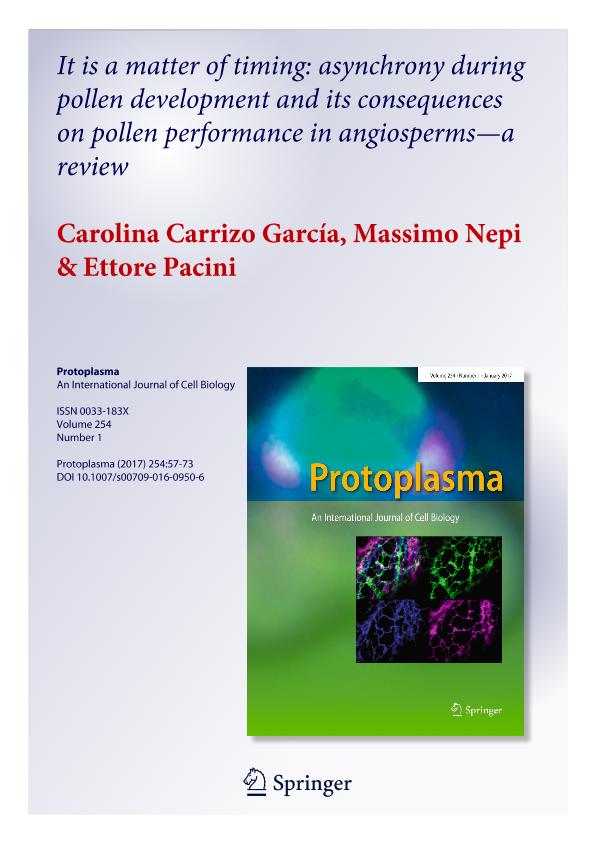Mostrar el registro sencillo del ítem
dc.contributor.author
Carrizo Garcia, Carolina

dc.contributor.author
Nepi, Massimo
dc.contributor.author
Pacini, Ettore
dc.date.available
2022-05-16T16:52:39Z
dc.date.issued
2017-01
dc.identifier.citation
Carrizo Garcia, Carolina; Nepi, Massimo; Pacini, Ettore; It's a matter of timing: asynchrony during pollen development and its consequences on pollen performance in angiosperms; Springer Wien; Protoplasma; 254; 1; 1-2017; 57-73
dc.identifier.issn
0033-183X
dc.identifier.uri
http://hdl.handle.net/11336/157623
dc.description.abstract
Functional pollen is needed to successfully complete fertilization. Pollen is formed inside the anthers following a specific sequence of developmental stages, from microsporocyte meiosis to pollen release, that concerns microsporocytes/microspores and anther wall tissues. The processes involved may not be synchronous within a flower, an anther, and even a microsporangium. Asynchrony has been barely analyzed, and its biological consequences have not been yet assessed. In this review, different processes of pollen development and lifetime, stressing on the possible consequences of their differential timing on pollen performance, are summarized. Development is usually synchronized until microsporocyte meiosis I(occasionally until meiosis II). Afterwards, a period of mostly asynchronous events extends up to anther opening as regards: (1) meiosis II (sometimes); (2)microspore vacuolization and later reduction of vacuoles; (3) amylogenesis, amylolysis, and carbohydrate inter-conversion; (4) the first haploid mitosis; and (5) intine formation. Asynchrony would promote metabolic differences among developing microspores and therefore physiologically heterogeneous pollen grains within a single microsporangium. Asynchrony would increase the effect of competition for resources during development and pollen tube growth and also for water during (re)hydration on the stigma. The differences generated by developmental asynchronies may have an adaptive role since more efficient pollen grains would be selected with regard to homeostasis, desiccation tolerance, resilience, speed of (re)hydration, and germination. The performance of each pollen grain which landed onto the stigma will be the result of a series of selective steps determined by its development, physiological state at maturity, and successive environmental constrains.
dc.format
application/pdf
dc.language.iso
eng
dc.publisher
Springer Wien

dc.rights
info:eu-repo/semantics/openAccess
dc.rights.uri
https://creativecommons.org/licenses/by-nc-sa/2.5/ar/
dc.subject
ASYNCHRONY
dc.subject
COMPETITION
dc.subject
DEVELOPMENT
dc.subject
HOMEOSTASIS
dc.subject
MICROSPORES
dc.subject
POLLEN
dc.subject.classification
Ciencias de las Plantas, Botánica

dc.subject.classification
Ciencias Biológicas

dc.subject.classification
CIENCIAS NATURALES Y EXACTAS

dc.title
It's a matter of timing: asynchrony during pollen development and its consequences on pollen performance in angiosperms
dc.type
info:eu-repo/semantics/article
dc.type
info:ar-repo/semantics/artículo
dc.type
info:eu-repo/semantics/publishedVersion
dc.date.updated
2022-05-12T06:48:19Z
dc.identifier.eissn
1615-6102
dc.journal.volume
254
dc.journal.number
1
dc.journal.pagination
57-73
dc.journal.pais
Austria

dc.journal.ciudad
Viena
dc.description.fil
Fil: Carrizo Garcia, Carolina. Consejo Nacional de Investigaciones Científicas y Técnicas. Centro Científico Tecnológico Conicet - Córdoba. Instituto Multidisciplinario de Biología Vegetal. Universidad Nacional de Córdoba. Facultad de Ciencias Exactas Físicas y Naturales. Instituto Multidisciplinario de Biología Vegetal; Argentina. Universita Degli Studi Di Siena. Dipartimento Di Scienze Ambientali "g. Sarfatti"; Italia
dc.description.fil
Fil: Nepi, Massimo. Università degli Studi di Siena; Italia
dc.description.fil
Fil: Pacini, Ettore. Università degli Studi di Siena; Italia
dc.journal.title
Protoplasma

dc.relation.alternativeid
info:eu-repo/semantics/altIdentifier/url/https://pubmed.ncbi.nlm.nih.gov/26872476/
dc.relation.alternativeid
info:eu-repo/semantics/altIdentifier/doi/http://dx.doi.org/10.1007/s00709-016-0950-6
Archivos asociados
